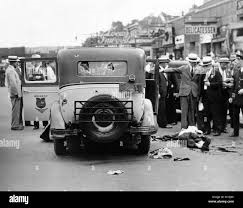The morning of May 8, 1929, dawned bright and crisp in Chicago. It was a day that would be forever etched in the city’s history, not for its sunshine, but for the bloodbath that unfolded at the behest of Al Capone, the notorious gangster who reigned supreme over the city’s underworld. The day before, an unprecedented truce had been brokered between Capone’s Chicago Outfit and the rival North Side Gang, led by the ambitious Bugs Moran. The uneasy peace was meant to allow a local beer distributor, Hymie Weiss, to meet with a rival gangster to discuss a new partnership. It was a facade of normalcy, a carefully orchestrated trap. As the sun rose on May 8th, a group of North Side Gang members, unaware of the deadly ambush that awaited them, arrived at a garage in a North Side neighborhood. They were there to pick up a shipment of beer, or so they thought. Instead, they were greeted by a squad of men disguised as police officers, wielding Tommy guns and sawed-off shotguns. The massacre that ensued was swift and brutal. The gunmen, believed to be members of Capone’s Outfit, stormed the garage, unleashing a volley of bullets. The North Side Gang members, caught completely off-guard, had no chance to fight back. They fell one after another, their bodies riddled with bullet holes. The carnage was complete in a matter of minutes. Seven men lay dead, including Frank "The Enforcer" Gusenberg, a close associate of Bugs Moran. The scene was one of utter chaos and blood. The assassins, disguised as police officers, escaped the scene seamlessly, leaving behind a trail of death and terror. The massacre, later dubbed the "Saint Valentine's Day Massacre," sent shockwaves through Chicago and beyond. It became a chilling symbol of the lawlessness that gripped the city and underscored the ruthlessness of the Chicago Outfit. The event also cemented Capone’s reputation as a ruthless and untouchable crime lord, even though he was never officially charged with the murders. The aftermath of the massacre brought swift and drastic measures. The police, under immense public pressure, launched a full-scale investigation. The city, once tolerant of the gangsters who held sway over its streets, now demanded justice. The public outcry forced the authorities to crack down on organized crime, but it was a battle already half-lost. The massacre of May 8, 1929, had lasting repercussions. It fueled public outrage against the rampant lawlessness and the influence of organized crime. The tragedy became a catalyst for public awareness and ultimately contributed to the implementation of stricter regulations and enforcement measures aimed at dismantling organized crime networks. The date itself remains a haunting reminder of the dark chapter in Chicago's history. While the perpetrators of the massacre were never definitively proven, the legacy of the "Saint Valentine's Day Massacre" continues to resonate as a testament to the brutal reality of the Prohibition era and the dark power wielded by Al Capone, the man who once ruled Chicago with an iron fist.
8 May, 1929 U.S.A. Gangsters Murdered
